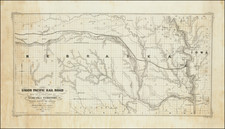Search
Peter Dey, together with a young assistant by the name of Grenville Dodge, is best known as leading the Union Pacific Railroad surveys in 1863 which resulted in the creation of a map which would be presented to President Abraham Lincoln, which resulted in Lincoln's selection of Omaha as the terminal point for the Transcontinental Railroad. Thereafter, Dey would become the UPRR's chief engineer, overseeing the survey of the route across the Black Hills at Cheyenne Pass and on to Utah and line's joinder with the line of the Central Pacific Rail Road, thereby completing the Transcontinental Railroad in May 1869.
Dey graduated from Geneva (now Hobart) College of Geneva New York. Thereafter, he began work work the New York and Erie Railroad Company as civil engineer. In 1849, he worked for the state of New York on the Cayuga & Seneca canal, building locks at Seneca Falls. Following this, he was engaged in the same line of work and for nearly the same length of time on the Erie canal at Port Byron. In the fall of 1850, worked for the Michigan Southern Railroad on its link to Chicago. In 1852, he worked with the Chicago & Rock Island Railroad, being in charge of division work from Peru to Sheffield, Illinois. There, he met Grenville M. Dodge, who afterward became famous as a general in the Civil War and prominent in railway construction. Mr. Dey gave General Dodge his first employment in railroad work.
Dey was engaged in various railway construction enterprises in Illinois until 1853, when he came to Iowa City, bringing with him General Dodge. In Iowa City he made the surveys for the Rock Island road from Davenport to Council Bluffs via Iowa City and Des Moines. In 1860 he was elected mayor of Iowa City.
Beginning in 1862, Dey began work with the Union Pacific Railroad, where he conducted the first survey and construction work of the Union Pacific Railroad. In September, 1862, he made a reconnaissance of the prospective route from the Missouri River to the Salt Lake Basin, with a view to ascertaining a practicable route and the probable resources of the country to be developed. He recommended against the proposed route via Denver, preferring a route crossing the Black Hills at Cheyenne Pass, which would be adopted as the final route of the first trans-continental railway.
In 1863, Dey, along with John A. Kasson, Thomas C. Durant, and T. J. Carter, went to Washington to ask the president to fix the eastern terminals of the proposed road. Dey had carefully prepared a map showing the approaches of the Chicago, Burlington & Quincy, the Chicago & Northwestern, and the Chicago, Rock Island & Pacific railways. From this map Mr. Lincoln decided that Omaha, Nebraska, would be the terminal for the western road.
Also in 1863, working with Thomas C. Durant, Dey ran some preliminary lines of survey over the Cheyenne Pass and the Bridger Pass, also between Omaha and the Platte Valley, and between Belleview and the Platte Valley, and at other points. This work was finished early in the fall of 1863, and on December 30, 1863, he was appointed chief engineer of the Union Pacific Rail Road.
Dey considered on as Chief Engineer until resigning in 1865 because of disagreements with Thomas Durant over the handling of business dealings, which would come to be known as the Crédit Mobilier scandal. Crédit Mobilier was a sham construction company chartered to build the Union Pacific Railroad by financing it with unmarketable bonds. It also provided a mechanism to dispense the immense profits from building the railroad to the board of directors and its shareholders.

